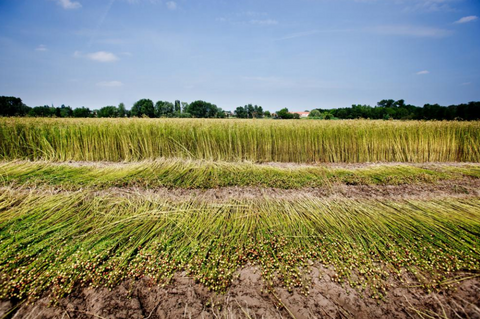Did you know that flax is grown only in the optimal climate of France, Belgium and The Netherlands? Here the soil and climate are optimal for flax production, so it’s no surprise that flax comes from Europe.
Our French linen are made from the finest flax of France. But be careful, to ensure the finest quality linens we all love, Flax has to be slowly processed with respect to traditional craftsmanship... that's how it is processed in France.
1. GROWTH & BLOOMING
The beginning of the Flax Season (March)
At the beginning of spring the flax farmers prepare to go into the fields again. They follow the changing of the seasons closely and wait patiently until the time is right for sowing. After merely 100 days, the flax will have reached a height of approximately 1 meter
Blooming (June)
The blooming flax attracts many people to the fields every year. A flax flower lasts only a single day. By the end of June the fields turn blue for a couple of days, after which the flowers disappear.

Pulling (July)
When flax is harvested, it is pulled rather than cut. The customized machines pull two rows of flax from the soil simultaneously. The flax is laid on its side and placed on the field in parallel rows. After this process, the fields are covered with green flax.

However, that soon changes…
Retting (August)
Mother Nature has a crucial role in the retting process where sun, dew and rain alternate. Micro-organisms dissolve the pectins and loosen the fibers. The soil also plays a part in the process. It contributes to the typical beige color of flax.
Retting can take up to two to six weeks, depending on the weather. Only an expert can determine whether the flax has been sufficiently retted. It is an important task. If the retting period is too short, the fibers are difficult to extract. If the period is too long, the fibers will start to rot, causing a decrease in tensile strength.
Harvest (September)
After retting, the flax is picked up by customized machines and tied together in large bales, weighing about 300 kilograms each. For a short time, these large flax bales adorn the fields.

After 5 months, it is now time free the Flax fibers
2. PROCESSING THE FIBER
SCUTCHING
or when the woody stems of the plants are broken in a machine to separate the fiber from the shives (the wood particles from the stem). The quality is assessed manually as soon as the flax comes out of the machine.

and nothing is wasted! The recovered shives are further processed into chipboards or animal bedding. The scutching tows are used for spinning coarser yarns or as raw material for the paper industry.

HACKLING
is thousands of pins comb the flax until only the purest fiber remains. The remaining short fibers, the hackle tow, are separated from the longer fibers, the line. The line is used to produce the finest textile.
The tow is processed into coarser yarn.

3. SPINNING THE YARN
Spinning Frame
Before the spinning starts, fibers of various fields and regions are mixed to obtain yarn of equal color and quality. Next, the line flax is fed across the flax spinning machine. The line is clamped between two rollers. Two more rollers below the first two rotate at a higher speed. The line is, thus, lengthened into a yarn of a certain metric count or weight.
`Bobbins
The spun yarn is wound on a spool. A ring travels around the spinning spool at a high speed to ensure an even distribution of the yarn. The spindles’ rotating movement twists the fibers to ensure the required torsion. This brings together the different fibers into a yarn. In the last stage, the yarn on the spools is combined into bigger bobbins.

4. WEAVING THE YARN
Preparation
Appropriate preparation is essential for efficient operation of the weaving mill. During the warping process, large metal beams are filled with warp yarn, sometimes up to 10 km. This is high-precision work with no margin for error. In the next step, three essential components for weaving are added to the warp beam: dropwires, heddles and reed.
Weaving
In the weaving mill, the rhythm of the looms can be heard day and night. The humidity is kept constant and quality is monitored around the clock.

Shearing of the loomstate Linen
After a strict quality control, the linen fabric is fed through a machine where shearing blades remove the last pills and impurities. This is a required step for a perfect finish.

The shearing dust is collected and upcycled. It can be used for paper or insulation production.
Finishing
Final Quality Control
After undergoing finishing the fabric is carefully inspected again. The color of the linen is checked under different light sources. It has to be consistent for the whole length and width of the fabric. The hand of the fabric is assessed manually.

After a thorough control, the linen is ready to be shipped to You! And you can be assured your product is of the finest quality.
Check out our new French linen goodies and Bliss Yourself!

